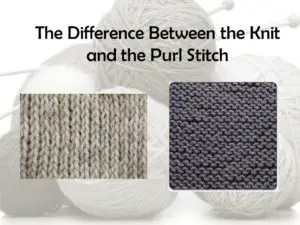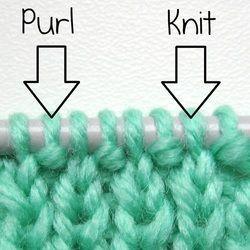Knit Vs Purl – Difference Between Knit and Purl
Jump To:

Knitting is a wonderful hobby that can be done by both an experienced knitter and someone who has never tried before. Learning the differences between knit and purl stitches is very important for beginners, so they do not get confused with their work or make mistakes in patterns! Let’s take a look at what makes these two types of stitches different, shall we?
K:Knit; P:Purl
Knit Vs Purl Stitch
There is not a big difference between knit and purl stitches. They are essentially the same things. Only they are mirrors of each other.

Knitting
Knitting starts with a row of knit stitches on the front and purl bumps behind it. To make each stitch, you need to pull the yarn through the loop from the backside to the front side before removing the needle (knit) or pushing into loops down away from the needles after pulling up new loops in the previous step (purl). When finished making both types of stitches, what results is a smooth knitted fabric where every other bump shows which way your knitting goes around the next stitch; because they’re not exactly opposite one another!
Purling
A purl stitch is the opposite of its counterpart, a knit. You stick your needle through both stitches (knit and purl) to create an X on one side; however, it goes from front to back with a knit stitch, whereas for a purl stitch, that same path would be back-to-front. When taking off each individual stitching pattern, you’ll see two different sides: A smooth knitted fabric will have the bump facing away/away from itself and vice versa – in terms of how they look when taken off their respective items while creating those patterns!
When you begin to master the basics of making knit and purl stitches, you can combine these two techniques to make many different kinds of fabric.
How to Knit Stitch
- Cast on roughly 10 to 12 stitches onto one of your needles.
- In right hand hold the empty needle, and in left hand hold the needle with the stitches cast on.
- Take the empty (right) needle and insert it into the first stitch of left needle.
- Push the needle through the stitch from front to back.
- Wrap the yarn counter-clockwise all around to front of the needle in right hand.
- Slide the right-hand needle down through the original stitch so that your right-hand needle should be in front of your left-hand needle.
- At this point, take the new stitch and slip it off the left-hand needle onto right-hand needle.
- Your knit stitch is completed. Repeat the steps until all your cast-on stitches are worked on your right needle.
How to Purl Stitch
- Like the knit stitch, take your empty needle in your right hand, and your needle with stitches in the left hand.
- Make sure your yarn is in front of your work.
- Insert your right needle from the back to the front of your first stitch.
- Wrap yarn counterclockwise around right needle until the yarn is in front of needles like at the start.
- Slide right needle down and move it through the loop.
- Slide the stitch off your left needle so that your purled stitch is on right needle.
- Repeat these steps until all of the stitches on your left needle are gone.
The purl and knit stitches are a bit tricky to learn, so we recommend you follow along with the video below until you get it. It’s okay if this takes some time!
Knit And Purl Stitches
Now that you’ve learned how knit and purl stitches are different and how to knit them, you can put it all together to create a few different types of stitches.
Stockinette Stitch
Knitting is a fun and simple craft to pick up. Many projects can be created with this one basic stitch, the stockinette! One of these stitches includes purling on both sides before turning around to knit again. When you’re done knitting, it will have two different colors depending on if your project was turned inside or outside out when finished – no matter which way makes more sense for what you are making.
Garter Stitch
A garter stitch is a type of knitted fabric that has alternating rows of knit and purl stitches. It’s typically used as an edge to prevent pieces from curling or rolling, making it especially useful for scarves and baby blankets. The thick nature also makes this stitch very sturdy – great for heavy winter coats!
Moss Stitch
Moss stitches are created by making 1 knit stitch, alternating with a purl stitch. This creates an interesting texture because of the bumpy pattern from the alternating stitches.
Ribbing
Ribbing is created by alternating knit and purl stitches to create a vertical stripe of either one. This effect creates an interesting ribbed pattern in your work that looks like waves with peaks and valleys from the tops of each stitch down.
Am I on a Knit or Purl Row?
Learning how to read your work is a helpful way of finding out where you are in stitches. Knit stitches look like little “V” s and purl look like horizontal lines or bumps. Take some time to familiarize yourself with what each stitch looks so that it will be easier for you to get back on track when necessary!
How to Switch from Knit to Purl
The trick to switching from knit to purl is the position of your yarn. You must constantly change its location between needles, and pay close attention! Here’s a helpful video on how it works:
Conclusion
The difference between knit and purl stitches is that one creates a bump on opposite side of what it’s attached to, while the other leaves a space. After reading this article, you should be convinced why learning these two crucial crochet techniques are important – by mastering them, you open up possibilities for creating different types of advanced patterns.
Is purl stitch easier than knit stitch?
What happens if you just purl?
If you purl every row then you’ll end up with garter stitch. If this sounds crazy, think about it: Traditionally, garter stitch is done by knitting every row. A purl stitch is also a knit stitch.
Can you knit without purl?
Knitting backward is exactly what it seems, instead of turning your work over after a knit row to purl the next row, you just knit that row backward and that produces the same result as purling that row. … This technique doesn’t only allow you to knit the stockinette stitch without purling and save you a bunch of time.
What is the difference between knit and stitch?
is that knitting is the action of the verb to knit ; the process of producing knitted material while stitch is a single pass of a needle in sewing; the loop or turn of the thread thus made.
What is the opposite of knit stitch?
A knit stitch (which you would have purled on the other side) just looks like a plain piece of yarn looped over the needle in a V shape, while a purl stitch has a little bump at the bottom. When you turn your work and are ready to start the next row look at the stitch you are about to work.
Why does my knit stitch look like a purl?
The most likely culprit is that you are wrapping your yarn the wrong way around your needle on either the knit side, the purl side, or both. You should always wrap the yarn counterclockwise around your needle.
What is Seed stitch?
Seed stitch consists of single knits and purls that alternate horizontally and vertically. Seed stitch gets its name from the texture of the knitted fabric — the little purl bumps look like scattered seeds. … Like garter stitch, seed stitch lies flat, making it a good edging for a sweater border and cuffs.
What happens if you knit every row?
It’s made by knitting every row. (You can create garter stitch by purling every row, too. Neat, huh?) You can recognize garter stitch by the horizontal ridges formed by the tops of the knitted loops on every other row.